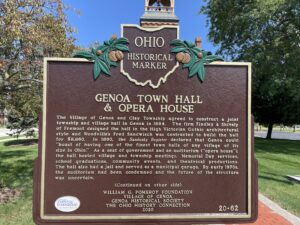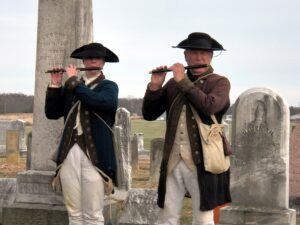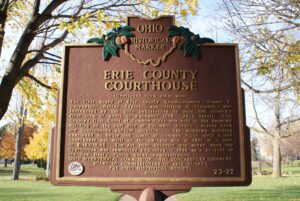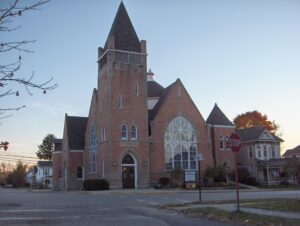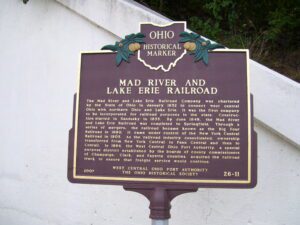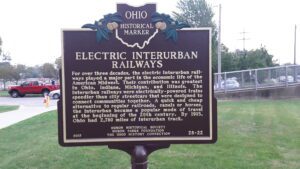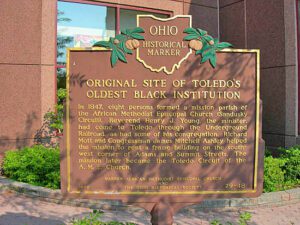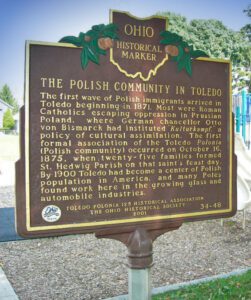, OH
The Village of Genoa and Clay Township agreed to construct a joint township and village hall in Genoa in 1884. The firm Findley & Shively of Fremont designed the hall in the High Victorian Gothic architectural style and Woodville’s Fred Sandwisch was contracted to build the hall for $8,860. In 1890, the Sandusky Register declared that Genoa could “boast of having one of the finest town halls of any village of its size in Ohio.” As a seat of government and an auditorium (“opera house”), the hall hosted village and township meetings, Memorial Day services, school graduations, community events, and theatrical productions. The hall also had a jail and served as a municipal garage. By early 1970s, the auditorium had been condemned and the future of the structure was uncertain. (Continued on other side)
, OH
Field Musician Richard W. Thompson. Tunes played on fife and drum regulated a soldier’s life in camp and his actions on the battlefield. Heard over the roar of battle and through the haze of smoke, fifes and drums – field music – communicated orders to massed troops quickly. Richard Willoughby Thompson (c. 1742-1837), buried in Fancher Cemetery, was a field musician during the American Revolution and the War of 1812. According to his grandson Henry’s recollections from the 1920s, Thompson was born in Dublin, Ireland, and enlisted in the British army, where his service culminated in his capture while picking blackberries. He switched allegiances, joined the colonials, and was sent to Virginia. Thompson was appointed the Fife Major of the 5th Virginia Regiment and remained a Fife Major as Virginia units organized during the war. (Continued on other side)
, OH
Jury of Erie County Women, First to be Impaneled Under Federal Suffrage proclaimed the headline of the Sandusky Register on August 28, 1920. One of the first female Court of Common Pleas juries in the nation was impaneled in Erie County on August 26, 1920, moments after the 19th amendment to the Constitution of the United States was declared ratified. On that date, Judge Roy Williams was to conduct a trial and jurors were needed. Out of the ten men he contacted, only one could serve. Frustrated, Judge Williams later told the women, “When I learned shortly after 10:30 this morning that suffrage had been proclaimed, I decided to impanel a woman jury. Twelve women were summoned. Twelve women served.” (continued on other side)
, OH
The Mechanicsburg United Methodist congregation was founded in the early nineteenth century and met first in open-air camp meetings before moving into a small log school building. In 1820 the congregation built a wood framed church on East Sandusky Street and that building was replaced with a brick structure in 1838. The congregation split in 1853 into Trinity Methodist and First Methodist with both groups serving the village of Mechanicsburg for 103 years before coming back together in 1956. The current United Methodist Church was built in the early 1890s and dedicated in 1894 on the corner of Main and Race Streets. The Gothic Revival style church was placed on the National Register of Historic Places in 1985.
, OH
The Mad River and Lake Erie Railroad Company was chartered by the State of Ohio in January 1832 to connect west central Ohio with northern Ohio and Lake Erie. It was the first company to be incorporated for railroad purposes in the state. Construction started in Sandusky in 1835. By June 1849, the Mad River and Lake Erie Railroad was completed to Springfield. Through a series of mergers, the railroad became known as the Big Four Railroad in 1890. It came under control of the New York Central Railroad in 1905. As the railroad industry consolidated, ownership transferred from New York Central to Penn Central and then to Conrail. In 1994, the West Central Ohio Port Authority, a special purpose district established by the boards of county commissioners of Champaign, Clark, and Fayette counties, acquired the railroad track to ensure that freight service would continue.
, OH
For over three decades, the electric interurban railways played a major part in the economic life of the American Midwest. Their contribution was greatest in Ohio, Indiana, Michigan and Illinois. The interurban railways were electrically-powered trains speedier than city streetcars that were designed to connect communities together. A quick and cheap alternative to regular railroads, canals or horses, the interurban became a popular mode of travel at the beginning of the 20th century. By 1915, Ohio had 2,780 miles of interurban track.
, OH
In 1847, eight persons formed a mission parish of the African Methodist Episcopal Church (Sandusky Circuit). Reverend Henry J. Young, the minister, had come to Toledo through the Underground Railroad, as had some of his congregation. Richard Mott and Congressman James Mitchell Ashley helped the mission to rent a frame building on the southwest corner of Adams and Summit streets. The mission later became the Toledo Circuit of the A.M.E. Church.
, OH
The first wave of Polish immigrants arrived in Toledo beginning in 1871. Most were Roman Catholics escaping oppression in Prussian Poland, where German chancellor Otto von Bismarck had instituted “Kulturkampf,” a policy of cultural assimilation. The first formal association of the Toledo Polonia (Polish community) occurred on October 16, 1875, when twenty-five families formed St. Hedwig Parish on that saint’s feast day. By 1900 Toledo had become a center of Polish population in America, and many Poles found work here in the growing glass and automobile industries.


